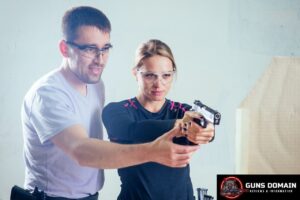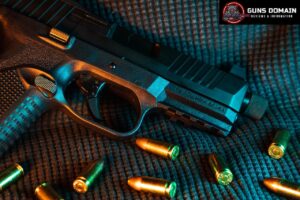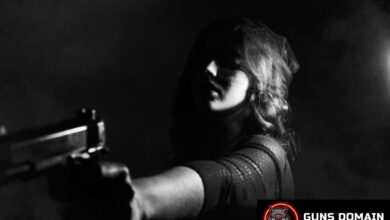Best Ways To Conceal Carry A Hand Gun
Best Ways To Conceal Carry A Hand Gun & Be Safe
Once you have your Concealed Carry license or permit, there are several ways that you can carry your handgun. The plethora of holster options include the traditional Outside-the-Waistband (OWB), Inside-the-Waistband (IWB), shoulder, ankle, pocket, small-of-the-back, appendix and belly band options, as well as several non-traditional methods like in a fanny pack, briefcase, day planner, and bra, etc. My experience over the years has convinced me that there is no consensus when it comes down to concealed carry. Personal preferences are important, but I recommend that you pay attention to two key points.
You should choose a method which allows you to conceal and carry your gun comfortably at all times. This can be difficult depending on the body type, build, clothing, lifestyle, temperature, location, and where you prefer to carry your gun. This can dictate where your handgun can be carried.
times. This can be difficult depending on the body type, build, clothing, lifestyle, temperature, location, and where you prefer to carry your gun. This can dictate where your handgun can be carried.
Shooters often refer to the position of their gun on their body by referring to the time displayed on a watch, e.g. Positions at 3 o’clock, 4 or 5 o’clock. Imagine yourself in the middle of a large clock. 12 o’clock is directly ahead of you, and 6 o’clock is behind you. You would place your right hip at 3 o’clock, and your left hip at 9 o’clock. If you’re a beginner, you can now visualize it like the image below. The majority of right-handed shooters carry their guns at 3, 4 or 5 o’clock.
You may need backup methods of carrying based on the lifestyle you lead and your personal factors. Once you have mastered the art of concealing a firearm, it will soon become part of your everyday routine. You will not even realize that you are carrying it.
You may need to try several methods depending on your attire, the type of work you do, whether you are a sportsperson or a recreational participant, or if you have special events or activities like weddings, church events, beach events or formal dress parties. The weather in your area can also influence the way you carry your bag. Weather conditions can be hot and humid with shorts and tee-shirts or cold, with a parka or heavy jacket. Most shooters carry their handgun at the waist, on the strong side. But you can also choose whether to carry it inside the waistband, outside, or off-body.
It is wise to plan for a variety carry methods depending on these variables as well as other personal preferences. You will need to practice and learn how to quickly present your firearm from the different methods of carrying. Consider these methods.
1. Secure your belt in an IWB holster

The best way to carry a concealed handgun is behind the back. You can also cross draw from your hip on the firing side, and cover it with a shirt, vest or sweater. This is the best way to carry a handgun concealed because it conceals the majority of the weapon, keeps it close by your body, and avoids the issuesassociated with carrying the gun inside your pants. I think this IWB conceals the weapon better, but it can be less convenient. The width of the belt may require you to wear a larger size of pants. It can take some time for your body to adjust to the additional pressure of the holster between your pant and body. If you want, you can buy the next size up in pants. However, this could be untidy depending on how big your body is. Some people also think that the baggy appearance of the pants does not look stylish. It’s your call.
The holster is CLIPPED onto your belt.
The same as before, the holster can be worn behind the back on either side of the hip (firing side) or crossed draw, support side, and is covered by a shirt or vest. IWB holsters have many options ranging from the appendix to the small part of the back.
Some say it is not as effective as a belt-mounted holster. Why? When you use a clip-on gun holster to present your weapon, the holster may still be attached. You could then point your gun at the bad guy while the holster is still attached. It is dangerous, but a good IWB clip can help.
2. In a holster OUTSIDE-the-waistband (OWB) on a belt
Cross draw or behind the back on the support side, with a shirt or vest covering it. Many shooters, including off-duty government agents and law enforcement officers in suits, use this method. It is easy to detect this method of concealed carry because the holster on the outside and the gun inside the belt create an unnatural mass in the area around the gun butt. The barrel end of holster can also be seen when the concealed carrier bends over or lifts his arms to do something (like putting luggage in a storage bin above or reaching for something high up). This is a very convenient method of carrying and I enjoy it, even when not wearing my suit. The choice of concealment garment, handgun model and width is very important. You can choose from a variety of styles and materials, such as leather, nylon or hybrid leather & kydex.
3. If you want to carry your gun underarm, use a holster that is SHOULDER-style (underarm), with or without tabs for attaching the belt. The holster can be covered by a jacket.
If you don’t want to carry your gun on your waistline, a shoulder holster is a great option. They are easy to conceal with a jacket while still allowing the handgun to be easily accessible. Most brands offer adjustable straps that can be customized to fit different body types. This can be an effective way to conceal carry with the right fitting holster. However, you will need to wear a jacket that is cut to accommodate the additional bulk of the gun and holster. It may look “cool” but it will require a lot of attention to make it fit correctly. Weight distribution is important for comfort. This can be achieved by using an off-side retention belt. It prevents the underarm strap on the other side from cutting into the armpit of the shooter and balances the gun’s weight. The holster is also exposed more often when the jacket opens due to body movement or breeze. The gun will be pointing at you when it is holstered. Most shoulder holsters are crossdraw holsters. This means that the gun will at some point be horizontally held and pointed away from you.
4. The ANKLE holster is covered by the pants
It is a great option for a backup weapon, as the ankle holster is a lot slower than other ways to carry a gun. This is ideal for people who sit a lot like professional drivers or kneel a lot. It may be useful in some situations because it’s easier to draw if you are kneeling or knocked down. The ankle holsters are made of the same material as the inside-the thigh holster, and may be an option for women who wear pants. It may be hard to reach when standing, and your walk and gait may change, giving away that you’re carrying.
5. FANNY PACK
You should be aware that you are probably not concealing your handgun from anyone who is watching (such as criminals or police officers), but that it will only affect a small number of people. It is known as “Off Body Carry”, and is how many women carry handguns. Men and women use briefcases, day planners and organizers as well as over-the shoulder pouches. Use an OBC with a lock, reinforced strap, and/or a locking device to ensure that it will not be grabbed, cut off from your waist or shoulder, or left somewhere. This method is the best way to keep a handgun nearby. The gun is concealed completely. The downside is that OBC handbags, purses and planners are easy to steal, forget or leave behind. Also, drawing from them can be slow, particularly if they’re locked. These methods are ideal for picnics, hot days, and the beach. Make sure that your gun fits inside the fannypack and that the Velcro or Snap enclosures are secure. It should be made specifically for your handgun.
6. In a HANDBAG or DAY PLANNER
OBC in a purse, handbag or briefcase is not as effective as a gun carried on the person. However, it will work in situations where you can’t carry a firearm on your body. Handbags, planners, and briefcases should all have a holster to secure the gun. For obvious reasons, you don’t want the gun to move inside the briefcase or purse. If you ever need to use it, you will know where it is. This is not the best method to carry if you tend to forget or lose your purse, planner or briefcase. This isn’t the way I carry my bag.
7. Around the waist, at the beltline or below.
A belly band is a large elastic belt that is tight around your hips, and secured with Velcro. The belly band has pockets for your handgun, spare magazine and other items. These bags are available in different sizes to fit different body types and work best for compact and sub compact handguns. Your friends may comment on how much you enjoy your full-size 1911 when you carry it. This option may be ideal for those who participate in sports like running or working out. The gun is on your body and it’s easy to access. If you sweat like I do, they may not fit well and will not remove sweat from your body. They could even make you sweat more. The rust on your gun and the direction in which the barrel points when it is inside the band are also important factors. Belly bands are flexible, allowing you to carry a variety of guns.
8. SMALL OF BACK (SOB),
This method involves tucking the handgun into a holster at the center of the back, where there is an indentation that is natural, usually around the 6 o’clock position, and inside your pants. Although SOB carry is comfortable and concealable when standing, it’s not the best choice for people who are driving or sitting down because of its awkwardness. Sitting for long periods of time can make it uncomfortable to have a metal piece in your middle back. There are many disadvantages to having a gun in your back. The gun can print more easily when you bend or stoop. In the event of an attack, a weapon that is in the middle back can be very difficult to defend. SOB carry is a controversial topic. Some people love it and some hate it. It’s all about personal preference and what you want.
9. Carry APPENDIX
This type of carry is named appropriately, as the handgun is carried inside your waistband, right next to the appendix.
Right-handed people should place their handguns at 2 o’clock. This is the most popular choice when it comes to small-to-medium-sized handguns. It’s located inside your pants, near your appendix. Remember that the gun will be pointed directly down at your femoral arterial and “junk” when you draw the holster. Some also say that it is uncomfortable when seated, but choosing an appropriately-designed holster will help. Some say you can conceal a full-sized pistol in shorts and a T-shirt, and that printing does not matter. This is influenced by body structure. Try it again and see what you prefer.
10. In a HIGH holster
It is also a good option for women, as a dress or skirt will conceal a firearm better than pants. The holster is lightweight and comfortable because it has Velcro and stretch elastic closures. The holster is usually held in place by silicone grippers on the top and bottom edge. This eliminates the need for a garter belt. Others say it is more secure, while others claim that the belt causes the holster to slip down the leg. Thigh holsters work well for sub compacts or mini guns but are not practical for women and men wearing pants. To access them, you have to remove your pants. Drawing and reholstering can be awkward, but concealment works well.
11. Under a dress or blouse, a BRA holster can be worn.
It is possible to reach under the shirt or blouse to access the handgun. It is easy to get the gun by tearing away buttons or lifting a blouse. A surprise element would be a plus. This bra holster poses a risk to my safety, but I’ve never experienced it first-hand. The handgun is aimed sideways at your support arm. I think there’s a high risk of accidentally pulling the trigger while the gun is holstered. This is especially true in stressful situations. I read the sad story of a Michigan woman who was a retired military police officer for the Navy. In February of this year, she shot herself in the face and died while adjusting her bra. Keep your finger off of the trigger until you are ready to fire.
12. No HOLSTER – Tuck inside pants
This is a common method of carrying a handgun. I don’t agree with this terminology but I’ve heard it called “Mexican”. This is an extremely common way to carry a handgun. It conceals it well, but only experienced shooters should consider this method. This is a common method of carrying and most associate it with street thugs and gangsters. It is not a safe method of carrying a gun. The trigger is left exposed, which increases the risk for a negligent discharge or injury. I never carry my gun in my pants without a holster. Too risky!
The majority of people who carry a gun in this manner are unaware of the dangers and problems associated with not having a holster. They will only learn the risks and dangers when they have to deal with them “hard”. Agun may fall out when running or moving quickly; it can also slide down under the belt and down the leg of the pants; you could have a bad drawing and the weapon might not be at the same spot each time you try to draw the weapon. Triggers are not protected, and clothing can also interfere.
Enjoying This Article? Read: The Best Winchester Rifles And Shotguns
13. POCKET Place the Holster in a pocket on your pants or shorts, either side or back.
We have many smaller handguns, including compact and subcompact models that are ideal for pocket carrying. Here is my NAA Black Window.22 WMR in a pocket holster. Old West gunslingers, gamblers, and sheriffs carried small guns in their pockets, such as small revolvers or derringers. I’ve read about old-timers who killed themselves with their pocket guns. The weight, dimensions and smoothness of the gun, its caliber, as well as your clothing and body movements will determine whether this is the best method for you. Recently, I’ve heard of people who shot themselves when they accessed, drew, or presented their gun from their holster. Most were injured at a sensitive location. You understand this isn’t the most preferred method or location to carry a gun. I warn pocket carriers to be careful not to leave their gun unattended in the pocket. The quality and type of your pocket-holster will also have a great deal to do with the success you’ll have in gaining access and drawing your gun. So, research and buy a holster that is well-designed and proven for this purpose… then practice your draw safely by dry-fire. Many high-quality pocket holsters are available. Galco, Safariland, DeSantis, NAA, Milt Sparks, Alessi, Rosen, etc. As you remove the handgun from the pocket, make sure the extensions on the top and bottom edge of the pocket holster catch the clothing pocket. This will ensure a safe and easy draw and access. Practice your drawing technique so that you can keep your hand in the correct position and not be obstructed. To avoid interference, your drawing hand (with the trigger finger being especially rigid and my thumb high up) should be straight when you enter the pockets. PRACTICE SAFELY with your pocket gun! A tip I learned about safe reholstering is to remove the empty holster out of your pocket, and then reholster the gun in it. Once the gun is safely holstered in its holster, you can return it to your pocket.
Consider your lifestyle, how you dress, where you live, what you do, and your body type to determine the best method of carrying your concealed handgun. You can try different methods until you find the one that works best for your gun and situation. Carry it with you at all times.
It is not intended to be accurate for all shooters. The author does not assume responsibility for anyone’s use of the information and shall not be liable for any improper or incorrect use of the information, damages or injuries incurred whatsoever. This article is not intended to be accurate and should not be relied on by all shooters. The author also assumes no liability for the use or misuse of this information.


